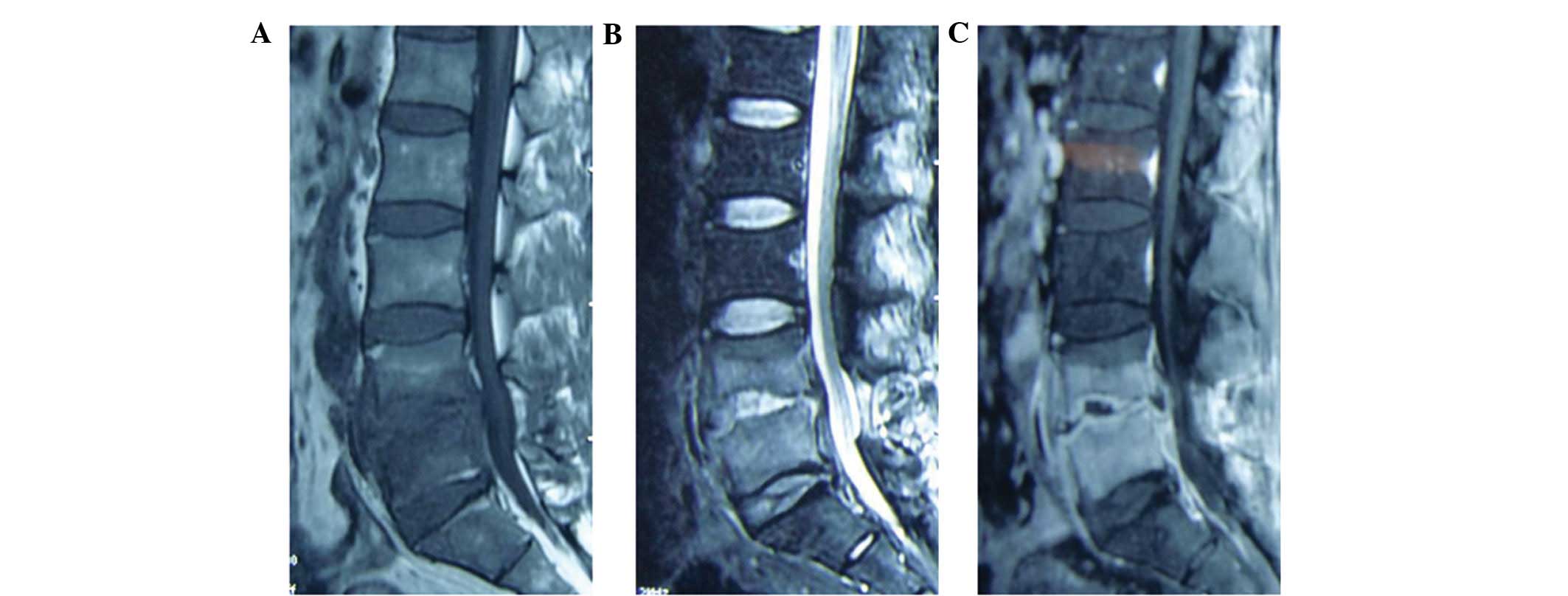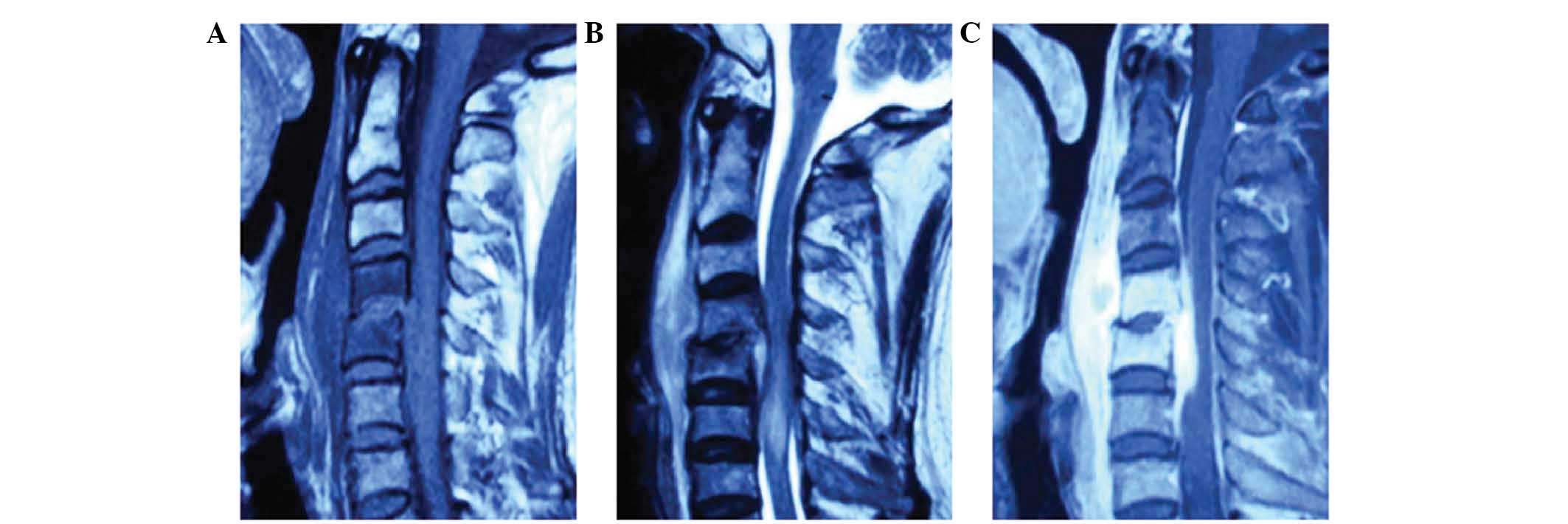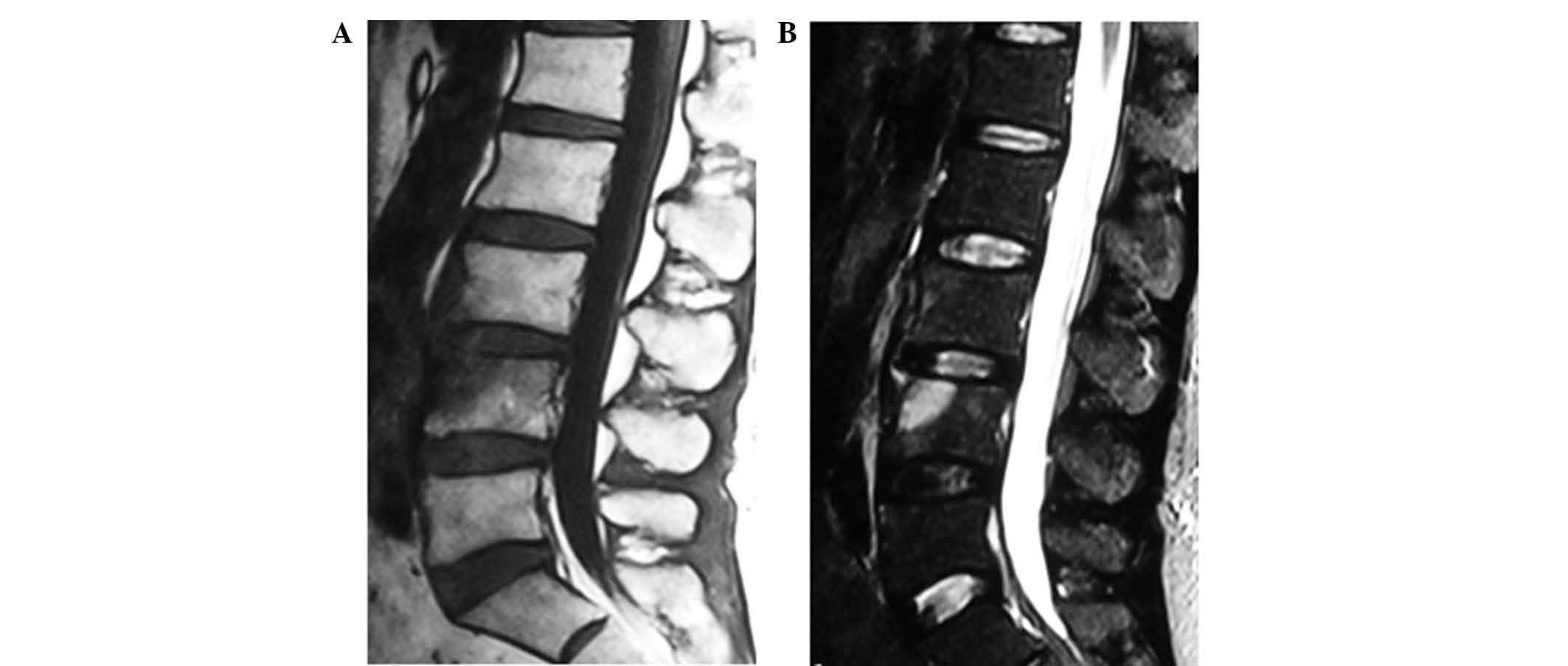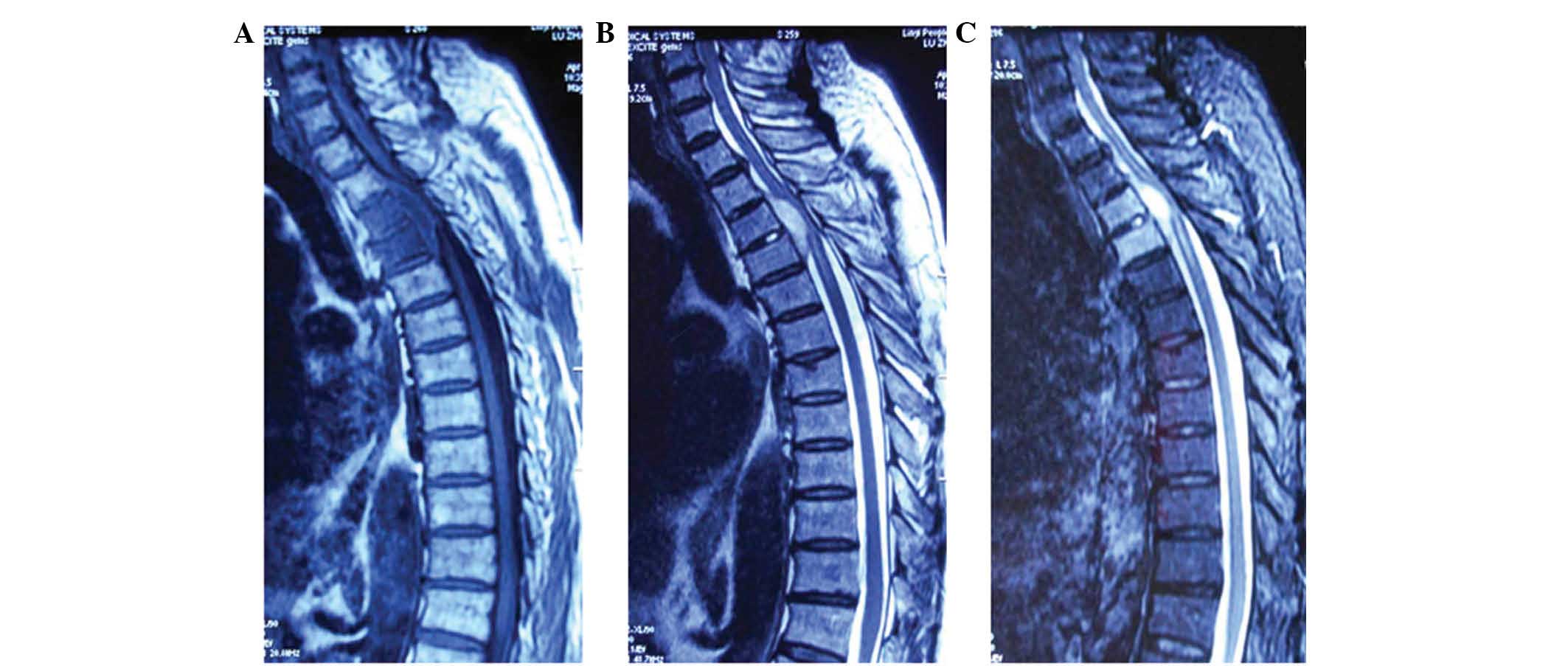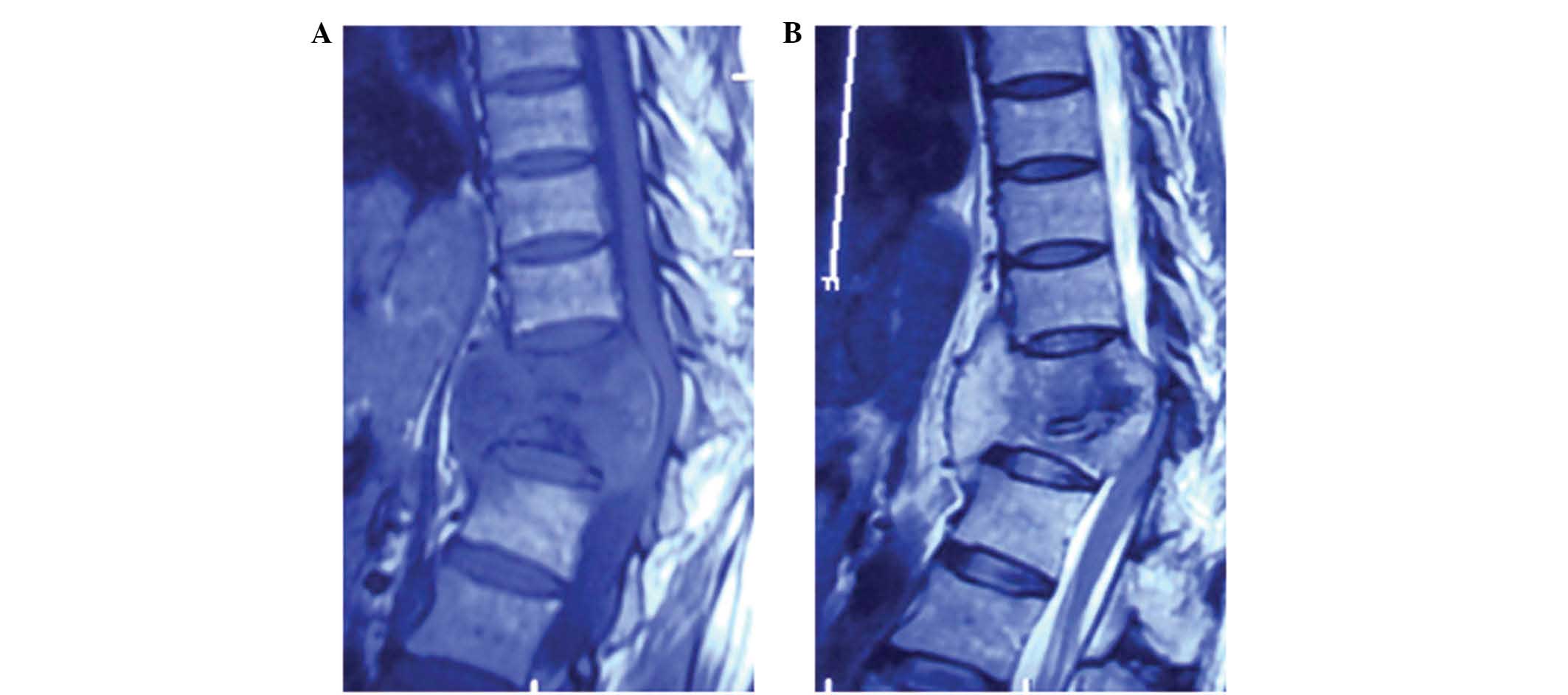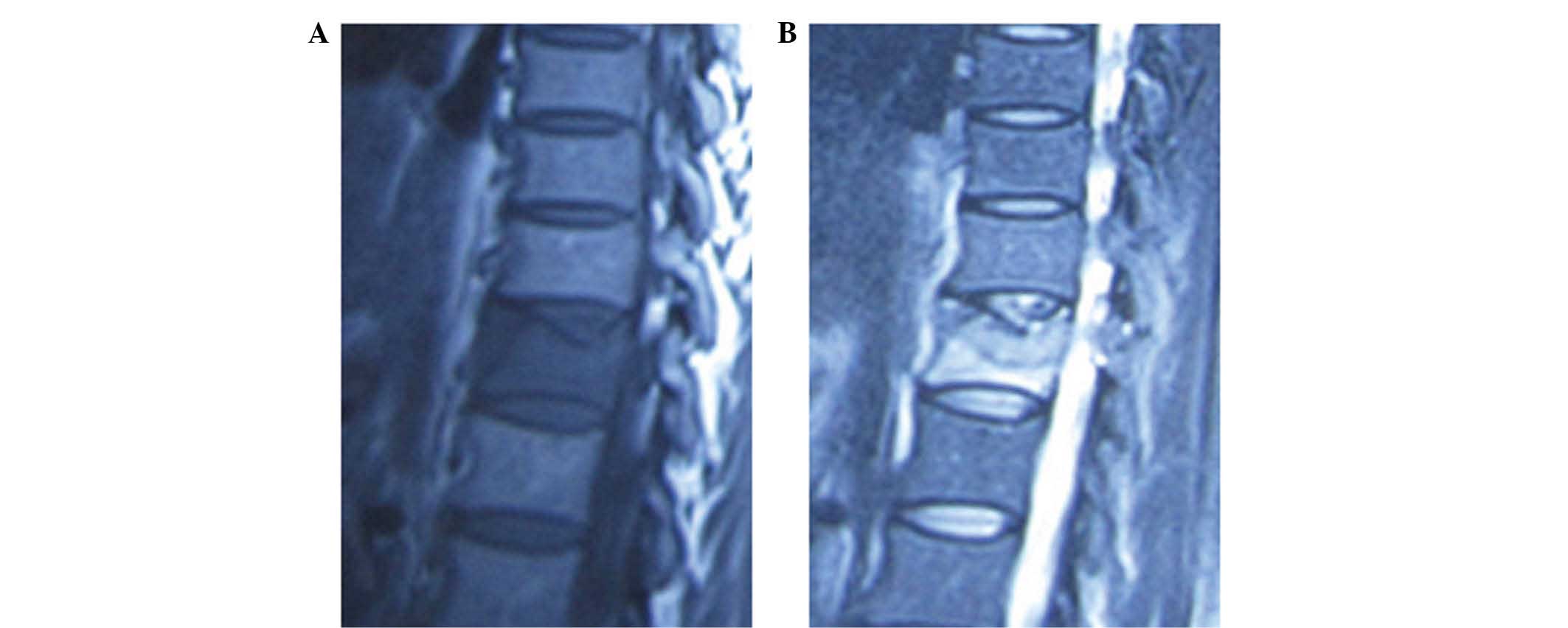Diagnosing pyogenic, brucella and tuberculous spondylitis using histopathology and MRI: A retrospective study
- Authors:
- Published online on: August 22, 2016 https://doi.org/10.3892/etm.2016.3602
- Pages: 2069-2077
-
Copyright: © Li et al. This is an open access article distributed under the terms of Creative Commons Attribution License.
Abstract
Introduction
Pyogenic spondylitis (PS) is regarded as a serious threat to human health worldwide (1); the disease accounts for 2–7% of all bone and joint infections, with an annual incidence of 0.2–2 cases/10 million people (2). In China, due to the increasing clinical use of antibiotics, typical early cases of PS are rare, thus increasing the difficulty of obtaining an early diagnosis (1). Brucella spondylitis (BS) is primarily induced by infection with the Brucella species, which accounts for 2–5% of all BS cases (3). Brucellosis is a common infectious disease in the Middle East, North America and Mediterranean region (4). According to previously published statistics, there are 5–6 million cases of brucellosis worldwide, and 500,000 new cases are reported each year (5,6). In China, brucellosis primarily occurs in the northeast and northwest areas, where animal husbandry industry is well developed (6). However, as the consumption of the dairy products increases, the incidence of the disease in cities and towns is increasing (7). Tuberculous spondylitis (TS) is the most dangerous and prevalent form of skeletal tuberculosis. Tuberculosis is caused by Mycobacterium tuberculosis, 3% of which is skeletal tuberculosis (8). Tuberculosis has been recognized as the leading cause of mortality from a curable infectious disease, and the WHO African region has the highest estimated incidence rate; however, the majority of patients with tuberculosis live in the most populated countries of Asia (9).
Early diagnosis of spondylitis is difficult in clinic due to its unusual signs and symptoms of fever and pain. There are numerous similarities in the imaging and clinical manifestations between PS, BS and TS; however, different treatments are required for each disease (10,11). Therefore, the early and correct diagnosis of spondylitis is important for timely and effective intervention, thereby reducing the occurrence of spinal deformity and dysfunction (12). Currently, histopathology and magnetic resonance imaging (MRI) are widely used examination methods for spondylitis in the clinic (13). Numerous investigators are identifying ways to improve the specificity and accuracy of diagnosing spondylitis according to clinical symptoms, laboratory tests (including white blood cell, C-reactive protein and erythrocyte sedimentation rate analysis) and radiographic analysis (including X-ray, computed tomography (CT), positron emission tomography-CT and MRI). However, there are few studies focusing on the combination diagnosis with histopathological and MRI examinations for spondylitis. In the present study, the histopathological and MRI features of spondylitis are retrospectively reviewed, and the application and value of the combination diagnosis is discussed.
Materials and methods
Subjects
The study included 22 patients with PS (gender, 12 male and 10 female; age, 26–69 years; average age, 53 years), 20 patients with BS (gender, 11 male and 9 female; aged 24–62 years, with an average age of 49 years), and 20 TS patients (10 males and 10 females, aged 22–57 years, with an average age of 45 years). Patients were admitted to the Provincial Hospital Affiliated to Shandong University (Jinan, China) between February 2012 and April 2014. Written informed consent was obtained from each patient, and the study was approved by the ethics committee of the Provincial Hospital Affiliated to Shandong University. Patients were divided into groups according to their disease: PS, BS and TS.
Patient inclusion criteria for the study were as follows: i) Patients diagnosed as spondylitis. Patients with PS were diagnosed by positive blood culture or positive bacterial culture of a biopsy specimen, and diagnosis was confirmed with clinical follow-ups. Patients with BS were diagnosed by positive blood culture, positive bacterial culture of a biopsy specimen, or a titer >1:160 in the brucellosis agglutination test (14), and diagnosis was confirmed with clinical follow-ups. Patients with TS were diagnosed by positive blood culture, positive bacterial culture of a biopsy specimen, or the detection of acid-fast bacilli by acid-fast staining, and diagnosis was confirmed with clinical follow-ups. ii) Adults (age, >18 years). iii) Patients with early spondylitis, with slight spinal lesions and early clinical symptoms. iv) Patients from whom the biopsy specimen was subjected to histopathological examination and bacterial culture. v) Patients who underwent MRI of the spinal lesions. vi) Patients with a complete date and follow-up period of >6 months. Patient exclusion criteria for the study were: i) Patients with autoimmune spondylitis. ii) Chronic cases confirmed at admission into hospital. iii) Patients suffering from spinal infection following surgery, or patients with advanced spondylitis. iv) Dropouts due to other reasons, or patients who did not complete the follow-up period.
Histopathological examination
Specimens were obtained by CT-guided percutaneous vertebral biopsy. The tissue was fixed with 10% formaldehyde, followed by decalcification with edathamil disodium. Once dehydrated, the tissue was embedded in paraffin and cut into sections (3–4 µm) using a microtome. The sections were then subjected to the hematoxylin-eosin staining, and observed under a microscope (BX51; Olympus Corporation, Tokyo, Japan).
MRI examination
MRI examination was performed using a medical Signa HDx1.5T scanner (GE Healthcare Life Sciences, Chalfont, UK) and a spine quadrature coil. The patient was laid in a supine position, with the head towards the scanner. Conventional T1-weighted images (T1WI) [repetition time (TR), 550 msec; echo time (TE), 14.2 msec; section thickness, 3 mm; intersection gap, 0.5 m; matrix, 256×256; number of excitations (NEX), 4; field of view (FOV), 33×33 cm] and T2-weighted images (T2WI) (TR, 3000 msec; TE, 120.0 msec; section thickness, 3 mm; intersection gap, 0.5 m; matrix, 256×256; NEX, 2; FOV, 32×32 cm) were obtained in the sagittal, coronal and horizontal planes. Gadolinium-diethylenetriamine pentaacetic acid (Jinan Luxin Chemical Technology Co., Ltd., Jinan, China) was injected to enhance imaging when necessary.
Statistical analysis
Data are presented as the mean ± standard deviation. SPSS version 17.0 (IBM SPSS, Amronk, NY, USA) was used for statistical analysis. One-way analysis of variance was used for group comparisons. P<0.05 was considered to indicate a statistically significant difference.
Results
Baseline characteristics
The baseline characteristics of all patients with spondylitis are summarized in Table I. No significant differences were observed in the gender, age and body mass index between patients in the PS, and BS and TS groups (P>0.05), indicating the patients were suitable for the investigation.
Histopathological findings
The analysis of results from the histopathological examinations of patients with PS, BS, and TS were retrospectively reviewed by five senior spine surgeons blinded to the study. The results demonstrated that there were no significant differences observed in the plasmocyte infiltration between the PS, BS and TS groups (P>0.05; Table II). However, significant differences were observed in the histopathological features across the PS, BS and TS groups (P<0.05). These features were sequestrum, new bone formation, epithelioid granuloma, Langerhans giant cells, caseous necrosis, neutrophil infiltration, and lymphocyte infiltration (Table II).
In particular, PS was characterized by predominant neutrophil infiltration, the incidence of which was significantly higher than that in the BS and TS groups (P<0.01; Fig. 1 and Table II). In addition, BS was characterized by histopathological features including new bone formation, epithelioid granuloma, and predominant lymphocyte infiltration, the incidences of which were significantly higher than those in PS and TS groups (P<0.01; Fig. 2 and Table II). Furthermore, TS was characterized by histopathological features including Sequestrum, Langerhans giant cells, and caseous necrosis, which were significantly different to the BS and PS groups (P<0.01; Fig. 3 and Table II). These results suggested that significant differences can be identified in the histopathological features between different types of spondylitis.
Lesion locations
The lesion locations were determined and analyzed in patients with PS, BS and TS. As shown in Table III, there were no significant differences observed between the PS, BS and TS groups in the cervical and sacral regions (P>0.05). However, for the thoracic and lumbar regions, significant differences were observed between the BS, PS and TS groups in the thoracic and lumbar regions (P<0.05).
The results showed that the majority of TS lesions were located in the thoracic region (60%), the incidence of which was significantly higher than that in the PS (14%) and BS (10%) groups (P<0.01). In addition, 75% of the BS lesions were located in the lumbar region, which was significantly higher than that in the PS (68%) and TS (35%) groups (P<0.01). These results suggested that significant differences can be identified in the location of lesions in different types of spondylitis.
MRI features
The MRI results of patients with PS, BS and TS patients were reviewed and analyzed. The results showed that no significant differences were observed between the following MRI features between the PS, BS and TS groups: Hypointense signal on T1-weighted images, hyperintense signal on T2-weighted images, presence of epidural abscesses, and involvement of multiple vertebral bodies (P>0.05, Table IV). However, significant differences were observed in the following MRI features between the PS, BS and TS groups: Intervertebral disk abnormality, lesion sites on the vertebral bodies (ventral and/or lateral sides), vertebral body deformation, paraspinal soft tissue abnormality, presence of intraosseous or paraspinal abscesses, appearance of abscess walls, facet joint involvement, and vertebral osteophyte formation (P<0.05; Table IV).
The incidence of the following MRI features was significantly higher in the PS group in comparison with the BS and TS groups, as indicated by the well-defined abnormal intervertebral disk signal, lesions on the ventral and lateral sides of the vertebral bodies, and thick and irregular abscess walls (P<0.05; Figs. 4 and 5; Table IV). In the BS group, the incidences of the following MRI features were significantly higher than those in the PS and TS groups: Lesions on the ventral sides of the vertebral bodies, no, or very mild, vertebral body deformation, normal paraspinal soft tissue signal, thin and irregular abscess walls, facet joint involvement, and vertebral osteophyte formation (P<0.05; Figs. 6 and 7; Table IV). In the TS group, the incidences of the following MRI features were significantly higher than those in the PS and BS groups: No obvious abnormal intervertebral disk signal, lesions on the lateral sides of the vertebral bodies, obvious vertebral body deformation, abnormal paraspinal soft tissue signal, presence of intraosseous or paraspinal abscesses, and thin and smooth abscess walls (P<0.05; Figs. 8 and 9; Table IV). These results suggested that significant differences are present in the MRI features between different types of spondylitis.
Discussion
Diagnosing spondylitis in the early stages is difficult due to its unusual signs and symptoms. However, the disease can develop and progress into chronic inflammation without a timely diagnosis and appropriate treatment (15–17). In the present study, the histopathological and MRI features of different types of spondylitis were analyzed and compared.
The analysis of results from the histopathological examinations showed that the sequestrum and bone repairing process is rarely observed in the early bone destruction experienced in PS, however, the sequestrum and new bone formation were simultaneously observed in BS. In TS, 50% of cases were accompanied with the sequestrum, but no evidence of new bone formation was observed, indicating the presence of severe bone destruction in the development of the disease. In addition, PS was characterized by the purulent exudates, without nodules. The histopathological characteristics of BS included granulomatous inflammation, but no caseous necrosis. These findings are in accordance with those observed in Yang et al (18). Granulomatous inflammation was also observed in TS; however, other histopathological changes, such as exudation, hyperblastosis and necrosis, may be expected, depending on the bacterial virulence and patient resistance. Notably, the typical histopathological changes of TS were observed to be the tuberculosis nodules, including caseous necrosis, epithelioid tissue and Langerhans giant cells, which may be used as markers for determining between different types of spondylitis (19). Neutrophils are the predominant infiltrating cell type in PS, and these cells are important in resisting pyogenic bacterial infection (20). However, BS samples are primarily infiltrated with lymphocytes, which may be attributed to the involvement of the humoral immune response in the early development of the disease (21). The predominant infiltrating cell type in TS was also the lymphocyte.
From the analysis of lesion locations in patients with spondylitis, 68.2% of the PS lesions were located in the lumbar region, findings that are consistent with those in Colmenero et al (10) and Antunes (18). In addition, 85% of BS cases were located in the lumbosacral region, also in agreement with previous studies (3,22–26). However, the majority of TS cases (60%) were located in the lower thoracic region, similar to results obtained by Turunc et al (27) and Jung et al (28).
The results of the MRI examinations in the present study demonstrated that no significant differences were present in the hypointense T1WI, and the hyperintense T2WI, between the PS, BS and TS groups. The MRI features of early PS included abnormal intervertebral disk signals (91%), which was not obvious in the MRI results of patients with BS. This finding of the abnormal intervertebral disk signal in MRI features of PS is in accordance with those of previous studies (29,30), which may be due to the fact that the lymphocyte infiltration was predominantly observed in the BS cases, suggesting the presence of cell immune responses (21), which would contribute to the lower incidence of intervertebral disk abnormalities in the disease pathogenesis. The incidence of intervertebral disk abnormalities in the TS group in the present study was 15%, and this low percentage may be attributed to the fact that Mycobacterium tuberculosis did not effectively decompose the intervertebral disk, which is in accordance with a previous study (31). Of note, the abnormal intervertebral disk signal was observed in the MRI results of three TS cases, in which Mycobacterium tuberculosis would destroy the endplate and then infiltrate into the intervertebral disk (31). In addition, uniform signals in the abnormal intervertebral disk were observed, with normal height but intense spot-like cystic signals, indicative of the suspected formation of a tuberculosis abscess that was identified to be a typical MRI feature for TS, which is in accordance with findings from Zhou et al (32).
In patients with PS, lesions were located on the ventral and lateral sides of the vertebral bodies, with an incidence of 91% in the present study. This phenomenon may be because PS is primarily caused by non-specific bacteria, and, therefore, the edema may quickly spread to the entire vertebral body; this could be used as a marker for the disease (1). In patients with BS, the lesions were mainly observed on the ventral sides of the vertebral bodies, with an incidence of 55%, which is in accordance with previous findings (29,33). These lesions in BS may be explained by the fact that the disease originates from the upper endplate with adequate blood supply, and the lesion may be limited within the ventral side of the vertebral body as a result of the non-invasive disease progression (29). In addition, consistent with previous findings from Turunc et al (27), the lesions in the TS group were primarily located on the lateral sides of the vertebral bodies, with an incidence of 50%, which may be regarded as a typical feature of the disease. However, Currie et al (13) demonstrated that TS may originate from the ventral side of the vertebral body near the endplate, and therefore the MRI feature of early TS may be edema within the endplate. Further in-depth studies are required to resolve this contradiction.
A total of 59% (13 cases) of the patients with PS experienced vertebral body deformation, including 10 cases of endplate destruction and 3 cases of vertebral bone destruction. In addition, 25% (5 cases) of patients with BS experienced vertebral body deformation, including 4 cases of wedge-shaped vertebral bodies with bone hyperplasia, and 1 case of moderate endplate and vertebral destruction. Furthermore, 90% (18 cases) of patients with TS experienced vertebral body deformation, including 12 cases of vertebral defect, 2 cases of wedge-shaped vertebral bodies, and 4 cases of moderate endplate and vertebral destruction. From these results, it is evident that PS is associated with diffuse lesions and bone destruction, while obvious bone destruction and spinal kyphosis deformity is associated with TS. On the other hand, lesions were limited in patients with BS, and new bone formation was observed during the bone destruction, resulting in non-altered or mild wedging morphology without obvious endplate damage (34). The results from the present study show that 40% of patients with BS experienced osteophytes due to hyperosteogeny, which was in accordance with previous findings (29).
The results from the present study show that abnormal signals with unclear boundaries were observed in the paraspinal soft tissue in early PS cases. Multiple small abscess cavities within the large abscess, which may be associated with the inflammation induced by the neutrophil proteolytic enzymes (35), were observed. In 66% (8 cases) of patients with PS, thick and irregular abscess walls were observed, a finding that is in accordance with Jung et al (28). Paraspinal soft tissue abnormality and abscesses were observed in 5 patients with early BS, the majority of which were single lesions with a small lesion area, and thin and irregular abscess walls, findings that are in accordance with those in Yang et al (36). It has been demonstrated that the paraspinal soft tissue and the psoas abscesses are involved in the development of TS (37). In the present study, the incidence of paraspinal soft tissue abnormality was 90% in the TS group, with an abscess incidence of 80%. In addition, 75% of TS cases were associated with the thin and smooth abscess walls, which is in accordance with previous findings (29,38). Furthermore, in the present study, the incidence of the involvement of multiple vertebral bodies in the PS, BS, and TS groups was 9, 5 and 5%, respectively. These incidences are slightly lower than previously published results (3,25,28). In the present study, epidural abscesses were rarely observed in the early stages of PS, BS and TS, which is in agreement with previous findings (13,33,38).
In conclusion, the results from the present study show that PS is histopathologically characterized by predominant neutrophil infiltration with no sequestrum, new bone formation, Langerhans giant cells and caseous necrosis. From the MRI features, PS lesions were primarily identified in the lumbar region, which may be characterized by the well-defined abnormal intervertebral disk signal, lesions on the ventral and lateral sides of the vertebral bodies, vertebral body deformation, paraspinal soft tissue abnormality with large and unclear boundaries, thick and irregular abscess walls, and multiple small abscess cavities, without the involvement of facet joints or the formation of osteophytes. In addition, the histopathological features of BS included predominant lymphocyte infiltration, sequestrum, new bone formation, and epithelioid granuloma, without Langerhans giant cells or caseous necrosis. Furthermore, the MRI features of BS were lesions, primarily in the lumbar region, mild intervertebral disk destruction, lesions on the ventral sides of the vertebral bodies, facet joint involvement, and vertebral osteophyte formation, with no, or very mild, vertebral body deformation and abnormal paraspinal soft tissue signal (the majority of which are single lesions with a small area, and thin and irregular abscess walls). The histopathological features of TS included predominant lymphocyte infiltration, sequestrum without new bone formation, epithelioid granuloma, Langerhans giant cells and caseous necrosis. The MRI features of TS were lesions, primarily in the thoracic region, very mild intervertebral disk damage, lesions on the lateral sides of the vertebral bodies, vertebral body deformation, abnormal paraspinal soft tissue signal (with a large area, and thin and smooth abscess walls), and rare involvement of facet joints and formation of osteophytes. These results suggest that histopathological and MRI analysis can distinguish between PS, BS and TS pathogenesis, which may contribute towards the ability to distinguish between PB, BS and TS during the diagnosis of spondylitis.
Acknowledgements
The authors thank Dr Chen Liang of the Department of Spinal Surgery, Provincial Hospital Affiliated to Shandong University (Jinan, China) for the kind assistance in the collection of data.
References
|
Cheung WY and Luk KD: Pyogenic spondylitis. Int Orthop. 36:397–404. 2012. View Article : Google Scholar : PubMed/NCBI | |
|
Sapico FL and Montgomerie JZ: Pyogenic vertebral osteomyelitis: Report of nine cases and review of the literature. Rev Infect Dis. 1:754–776. 1979. View Article : Google Scholar : PubMed/NCBI | |
|
Solera J, Lozano E, Martínez-Alfaro E, Espinosa A, Castillejos ML and Abad L: Brucellar spondylitis: Review of 35 cases and literature survey. Clin Infect Dis. 29:1440–1449. 1999. View Article : Google Scholar : PubMed/NCBI | |
|
Colmenero JD, Cisneros JM, Orjuela DL, Pachón J, Garcia-Portales R, Rodriguez-Sampedro F and Juarez C: Clinical course and prognosis of Brucella spondylitis. Infection. 20:38–42. 1992. View Article : Google Scholar : PubMed/NCBI | |
|
Wang Dali and Zhang Shiyi: Advances in treatment of acute brucellosis. Zhong Guo Gan Ran Kong Zhi Za Zhi. 16:94–95. 2001.(In Chinese). | |
|
Shang DQ: Research advances in brucellosis disease. Zhong Guo Gan Ran Kong Zhi Za Zhi. 19:204–212. 2004.(In Chinese). | |
|
Lin C and Liu X: Analysis of brucellosis infection through diet. Zhong Guo Ren Shou Gong Huan Bing Xue Bao. 17:58–59. 2001.(In Chinese). | |
|
Koh DM, Bell JR, Burkill GJ, Padley SP and Healy JC: Mycobacterial infections: Still a millennium bug-the imaging features of mycobacterial infections. Clin Radiol. 56:535–544. 2001. View Article : Google Scholar : PubMed/NCBI | |
|
Dye C: Global epidemiology of tuberculosis. Lancet. 367:938–940. 2006. View Article : Google Scholar : PubMed/NCBI | |
|
Colmenero JD, Jiménez-Mejías ME, Sánchez-Lora FJ, Reguera JM, Palomino-Nicás J, Martos F, de las Heras J García and Pachón J: Pyogenic, tuberculous, and brucellar vertebral osteomyelitis: a descriptive and comparative study of 219 cases. Ann Rheum Dis. 56:709–715. 1997. View Article : Google Scholar : PubMed/NCBI | |
|
Yilmaz MH, Mete B, Kantarci F, Ozaras R, Ozer H, Mert A, Mihmanli I, Ozturk R and Kanbergoglu K: Tuberculous, brucellar and pyogenic spondylitis: comparison of magnetic resonance imaging findings and assessment of its value. South Med J. 100:613–614. 2007. View Article : Google Scholar : PubMed/NCBI | |
|
Bettini N, Girardo M, Dema E and Cervellati S: Evaluation of conservative treatment of non specific spondylodiscitis. Eur Spine J. 18:(Suppl 1). 143–150. 2009. View Article : Google Scholar : PubMed/NCBI | |
|
Currie S, Galea-Soler S, Barron D, Chandramohan M and Groves C: MRI characteristics of tuberculous spondylitis. Clin Radiol. 66:778–787. 2011. View Article : Google Scholar : PubMed/NCBI | |
|
Zhao GM, Li F, Sun TS, Wu J, Guan K and Zhang ZC: Diagnosis and treatment of Brucella spondylitis. Zhong Guo Ji Zhu Ji Sui Za Zhi. 17:437–439. 2007.(In Chinese). | |
|
Yee DK, Samartzis D, Wong YW, Luk KD and Cheung KM: Infective spondylitis in Southern Chinese: A descriptive and comparative study of ninety-one cases. Spine. 35:635–641. 2010. View Article : Google Scholar : PubMed/NCBI | |
|
Fukuda K, Miyamoto H, Uno K and Okada Y: Indications and limitations of conservative treatment for pyogenic spondylitis. J Spinal Disord Tech. 27:316–320. 2014. View Article : Google Scholar : PubMed/NCBI | |
|
Yoon YK, Jo YM, Kwon HH, Yoon HJ, Lee EJ, Park SY, Pary SY, Choo EJ, Ryu SY, Lee MS, et al: Differential diagnosis between tuberculous spondylodiscitis and pyogenic spontaneous spondylodiscitis: A multicenter descriptive and comparative study. Spine J. 15:1764–1771. 2015. View Article : Google Scholar : PubMed/NCBI | |
|
Yang X, Shi W, Du YK, Meng XY and Zou YW: Imaging manifestations and pathological characters of the brucellar spondylitis. Shi Yong Fang She Xue Za Zhi She. 24:522–525. 2008.(In Chinese). | |
|
Duan H, Yang H, Zuo J, Chen G, Zhou L and He Y: Analysis: Pathology of 6 cases spine tuberculosis. Sheng Wu Gu Ke Cai Liao Yu Lin Chuang Yan Jiu Za Zhi She. 8:1–3. 2011.(In Chinese). | |
|
Li Y and Tang J: Pathology. 6th version. People's Medical Publishing House; Beijing: 2006, View Article : Google Scholar | |
|
Zhong X, Chen Z and Huang K: Research advance on Brucellosis virulence factors and treatment. Xu Mu Yu Shou Yi. 40:96–101. 2008.(In Chinese). | |
|
Antunes JL: Infections of the spine. Acta Neurochir (Wien). 116:179–186. 1992. View Article : Google Scholar : PubMed/NCBI | |
|
Mete B, Kurt C, Yilmaz MH, Ertan G, Ozaras R, Mert A, Tabak F and Ozturk R: Vertebral osteomyelitis: Eight years' experience of 100 cases. Rheumatol Int. 32:3591–3597. 2012. View Article : Google Scholar : PubMed/NCBI | |
|
Colmenero JD, Ruiz-Mesa JD, Plata A, Bermúdez P, Martín-Rico P, Queipo-Ortuño MI and Reguera JM: Clinical findings, therapeutic approach, and outcome of brucellar vertebral osteomyelitis. Clin Infect Dis. 46:426–433. 2008. View Article : Google Scholar : PubMed/NCBI | |
|
Ariza J, Gudiol F, Valverde J, Pallarés R, Fernández-Viladrich P, Rufí G, Espadaler L and Fernández-Nogues F: Brucellar spondylitis: A detailed analysis based on current findings. Rev Infect Dis. 7:656–664. 1985. View Article : Google Scholar : PubMed/NCBI | |
|
Glasgow MM: Brucellosis of the spine. Br J Surg. 63:283–288. 1976. View Article : Google Scholar : PubMed/NCBI | |
|
Turunc T, Demiroglu YZ, Uncu H, Colakoglu S and Arslan H: A comparative analysis of tuberculous, brucellar and pyogenic spontaneous spondylodiscitis patients. J Infect. 55:158–163. 2007. View Article : Google Scholar : PubMed/NCBI | |
|
Jung NY, Jee WH, Ha KY, Park CK and Byun JY: Discrimination of tuberculous spondylitis from pyogenic spondylitis on MRI. Am J Roentgenol. 182:1405–1410. 2004. View Article : Google Scholar | |
|
Özaksoy D, Yücesoy K, Yücesoy M, Kovanlikaya I, Yüce A and Naderi S: Brucellar spondylitis: MRI findings. Eur Spine J. 10:529–533. 2001. View Article : Google Scholar : PubMed/NCBI | |
|
Ledermann HP, Schweitzer ME, Morrison WB and Carrino JA: MR imaging findings in spinal infections: Rules or myths? Radiology. 228:506–514. 2003. View Article : Google Scholar : PubMed/NCBI | |
|
Almeida A: Tuberculosis of the spine and spinal cord. Eur J Radiol. 55:193–201. 2005. View Article : Google Scholar : PubMed/NCBI | |
|
Zhou J: The early diagnostic value of MRI on spinal tuberculosis. Zhong Guo Zhong Xi Yi Jie He Ying Xiang Xue Za Zhi. 4:362–364. 2010.(In Chinese). | |
|
Çelik AK, Aypak A and Aypak C: Comparative analysis of tuberculous and brucellar spondylodiscitis. Trop Doct. 41:172–174. 2011. View Article : Google Scholar : PubMed/NCBI | |
|
Wu W, Liu B, Liu Z, Cui SJ and Guo HB: MRI in the differential diagnosis of brucella spondylitis and spinal tuberculosis. Zhong Guo Mei Rong Yi Xue. 21:140–141. 2012.(In Chinese). | |
|
Zhou S, Wang J, Zhao X and Fan C: MR imaging manifestations and staging of pyogenic spondylitis. Ying Xiang Zhen Duan Yu Jie Ru Fang She Xue. 20:218–221. 2011.(In Chinese). | |
|
Yang XM, Shi W, Du YK, Meng XY and Zou YW: Manifestation of clinical imageology and surgical treatment of the brucellosis spondylitis. Orthop J Chin. 19:1463–1466. 2007. | |
|
Hong SH, Kim SM, Ahn JM, Chung HW, Shin MJ and Kang HS: Tuberculous versus pyogenic arthritis: MR imaging evaluation. Radiology. 218:848–853. 2001. View Article : Google Scholar : PubMed/NCBI | |
|
Yang JZ, Wang CJ, He FL, Chen SW and Huang YF: MR imaging of spondylitis (report of 11 cases). Zhong Guo Yi Xue Ying Xiang Ji Shu. 15:488–489. 2002.(In Chinese). |






